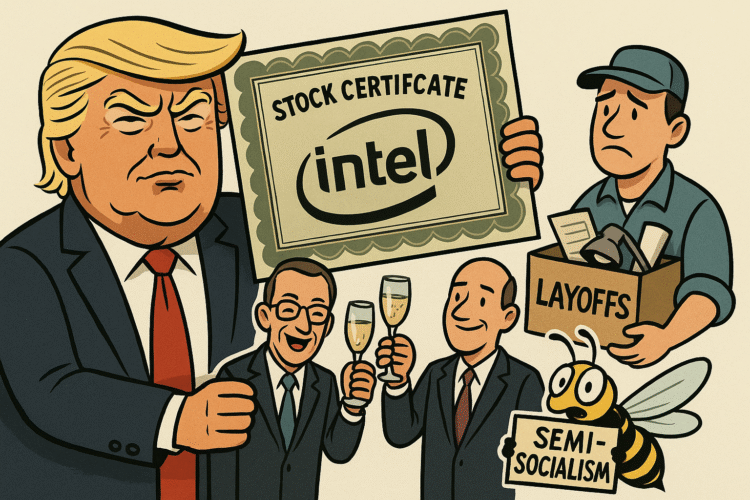
On August 22, 2025, President Donald Trump announced that the U.S. government is now the proud owner of 10% of Intel. That’s right—your tax dollars have been converted into ~433.3 million non-voting shares priced at $20.47 each. Wall Street analysts say the investment is worth between $8.9 billion and $11.1 billion, depending on whether you count unpaid grants and separate defense contracts.
So after years of railing against socialism, Washington has quietly birthed its own flavor of semi-state ownership, wrapped in the Stars and Stripes and sold as national security. Rand Paul is calling it government overreach, MAGA diehards are calling it genius, and the rest of us are just marveling that the federal government is now a stockholder in a company that lost $22 billion since 2023.
The Paper Gain That Launched a Thousand Press Releases
Intel stock closed at $24.80 on day one, meaning taxpayers scored a $1.9 billion paper profit instantly. The White House called it proof of Trump’s brilliance, as though buying stock below market price was a new invention. What they didn’t mention: Intel plans 20,000 layoffs while pocketing federal funds. Nothing says “Make America Great Again” like subsidizing pink slips.
The Official Spin
Supporters call this a bold national-security bet: a way to counter China, reshore semiconductor manufacturing, and revive Intel’s crumbling foundry ambitions. It’s all about safeguarding the future of AI hardware. Because nothing screams “21st-century security” like handing billions to a company still trying to figure out how to etch 7-nanometer chips while Taiwan laps it six times over.
The White House insists the stake is “passive.” No board seats. No votes. Just Uncle Sam sitting quietly in the corner, a very large silent partner who paid the cover charge but swears he won’t dance.
The Intel Soap Opera
Intel CEO Lip-Bu Tan was, just a week ago, under fire for supposed “China ties.” Trump hinted darkly about selling U.S. secrets to Beijing, and Republicans were sharpening their resignation letters. Then came a White House meeting, after which Trump declared Tan “a true patriot.” Days later, Washington announced its shiny new Intel shares. It’s amazing how fast loyalty can be manufactured when billions change hands.
DOGE Meets Silicon Valley
This move fits perfectly into Trump’s broader bureaucratic remodeling: gut the “deep state,” create DOGE (the Department of Government Efficiency), and replace advisory committees with Elon Musk’s Twitter polls. Now add semi-state corporate ownership to the toolkit.
This isn’t industrial policy. It’s cosplay corporatism. The government isn’t investing in infrastructure, R&D, or workers. It’s buying stock in a struggling giant to claim it “owns” the future. Imagine if Roosevelt had tackled the Great Depression by buying Blockbuster shares.
Semi-Socialism for Billionaires
Trump has spent years railing against socialism. But this is socialism for shareholders. Intel gets guaranteed lifelines. The government gets to brag about short-term profits. Workers get layoffs. And taxpayers? They get to pretend they’re all part of Silicon Valley’s boardroom hustle.
Rand Paul isn’t wrong when he calls it extraordinary government overreach. But he’s also missing the point: this isn’t socialism, it’s nationalism disguised as capitalism. The kind of arrangement where the state props up “strategic industries” not to serve people, but to serve geopolitics.
The Market’s Euphoria
Intel’s stock jumped 5–6% on the news. Investors love nothing more than a government that buys in high, bails out fast, and guarantees stability. This wasn’t about faith in Intel’s management. It was about faith in Washington’s willingness to pour your money into a sinking ship and call it a navy.
The Pattern: Government by Stakeholding
Analysts whisper this could be a template for Micron or even TSMC’s U.S. plants. Officials swear there are “no current plans.” That’s Washington code for: wait a few months. Once you start buying stocks with public funds, it’s hard to stop. The logic is self-reinforcing: the U.S. can’t let “strategic firms” fail. So the government becomes their biggest shareholder. National capitalism with MAGA branding.
The Irony of It All
Intel lost $22 billion in two years. Its innovation pipeline is clogged. Its workforce is shrinking. And now it has a 10% partner with no voting rights. That’s not strategy. That’s a participation trophy stapled to a balance sheet.
The government just became the world’s least demanding shareholder. No board seat, no oversight, no say in executive pay. Just a big check and a request that Intel build shiny fabs in Ohio. It’s like buying into a casino, refusing to play, and then calling yourself a winner.
The Bee’s-Eye View
Picture it: a cartoon bee buzzing through Intel HQ. On one side, executives celebrate billions in federal funding with champagne. On the other side, workers pack boxes after layoffs. In the corner, Uncle Sam holds a stock certificate and beams, shouting: “Look, I’m an investor!”
The bee hovers, unimpressed, holding a placard that says: “You can’t eat paper gains.”
The Closing Sting
Trump’s Intel deal isn’t about semiconductors. It’s about symbolism. It’s about showing voters that MAGA capitalism can be both anti-China and pro-corporate, both nationalist and shareholder-friendly. It’s about buying influence in the market without admitting you’re nationalizing anything.
But the truth is simple: the U.S. government just became one of Intel’s largest shareholders. Not through innovation, not through oversight, but through checkbook nationalism. The same president who rails against socialism just invented his own version of it: corporate socialism, MAGA-style, where billion-dollar firms get lifelines, workers get pink slips, and citizens get a flag-wrapped stock certificate for a company still trying to find its future under fluorescent lights.
History will not call this industrial strategy. History will call it what it is: the day America stopped investing in people and started investing in paper.